If you want your power tools to last, you need to look after them – it’s as simple as that.
And that means regular maintenance and cleaning are essential. In theory, this is fine, but it’s not always a straightforward operation. Some tools are more complex than others, and it’s not always clear how you should go about cleaning them properly.
Today, I’m focusing on one particular tool: the electric chainsaw. They are very different to petrol models, and while they generally need less maintenance, they do need to be kept clean.
If you want to know how to clean an electric chainsaw, then you might find this step-by-step guide pretty helpful.
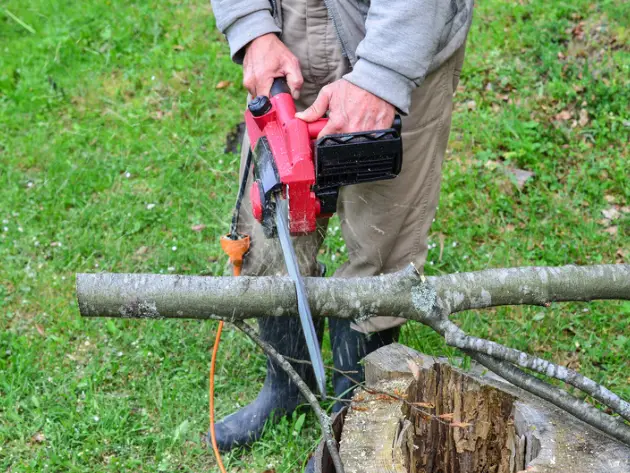
Step One: Preparation
The first stage in any successful process is to be prepared. So, set out a safe working area and gather all the equipment and tools needed, such as:
- A bowl of warm water
- Degreaser or universal cleaner
- Lubricating oil
- A putty knife
- A wire brush
- Bar groove cleaner or thin screwdriver
- A bowl containing water and ammonia solution
- Dry cloths
- Thin piece of wire
- Paper towels
- A clean, dry paintbrush (small)
- Safety gloves
Ideally, your chainsaw should be placed on a table or level surface that allows you access to all sides at a comfortable height. Most importantly, you need to disconnect it from a power source – make sure that the machine is unplugged or the battery is removed. Apply the chain brake if your machine has one.
There should be absolutely no chance of the chainsaw starting up during the cleaning process.
As a double precaution, it’s a good idea to remove the fuse from the plug.
Step Two: Clean The Chain
The chain and guide bar are usually connected to the power head by two nuts on the side cover plate. Loosen and remove the nuts with a hexagonal wrench and keep them in a safe place. Use the tightening knob to loosen and remove the bar and chain.
Remove the chain from the bar using safety gloves. A chainsaw chain is designed to slice through hard wood. Even when it’s not in motion, it can still easily tear your skin.
A chainsaw chain gets extremely dirty as it picks up sap and resin along with sawdust and dirt. This sometimes makes them difficult to clean, so you’ll need some extra help here.
Pat the chain with paper towels to remove any excess oil or debris and place it in the bowl of water and household ammonia* solution. Leave this for about thirty minutes to allow the ammonia to break down the oil and dirt, then remove it from the solution and scrub well using the stiff brush.
*Take necessary precautions when using ammonia! Work in a well-ventilated area and never mix ammonia with any other chemical, especially bleach.
Wash down with clean water and dry carefully with a clean, dry cloth, then apply a suitable lubricant. Some experts suggest leaving the chain in a shallow container of bar and chain oil for about three hours, but this is up to you.
Leave to one side while you clean the rest of the machine.
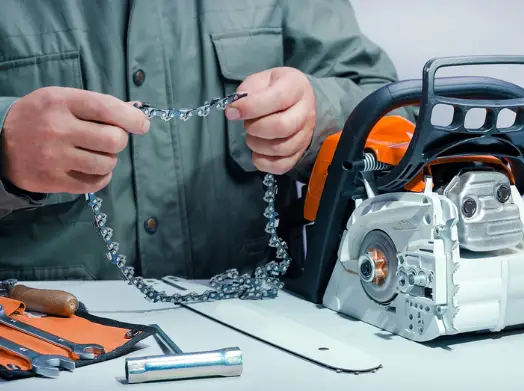
Step Three: The Guide Bar
This part picks up all kinds of dirt that gets stuck in the groove. If you have a bar groove cleaner, use this to dig out the gunk from inside the groove. If not, a small screwdriver will work just as well.
You can also use compressed air to do this, but wear safety glasses to prevent debris from getting in your eyes! If you have an air compressor, make sure it is on a low setting.
Use a thin piece of wire to clear the oiler holes along the guide bar, as these allow the chain to be lubricated while in use.
Soak a cloth in cleaning liquid or degreaser and wipe the guide bar down thoroughly to remove all the dirt. Rinse it with clean water and dry thoroughly.
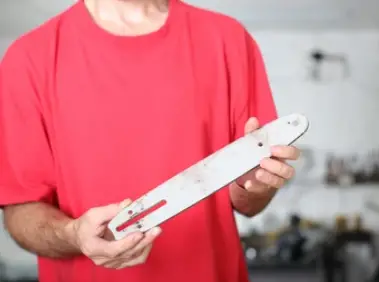
Step Four: The Powerhead
The powerhead is a fancy name for the part where the motor is housed. This is usually sealed as you don’t need to go near those complex electronics, but dust can get into the nooks and crannies. Use a stiff, dry paint brush to gently sweep away all the grime and dust from vents and recesses around the crankcase area.
Compressed air works well here, too. A few gentle puffs of air will remove the dust and dirt nicely. You can use a compressed air canister or use an air compressor on a low setting.
It’s important that you don’t use water on the powerhead. If water enters the casing and comes into contact with the electrics or any other components, it could damage the machine or result in an electric shock.
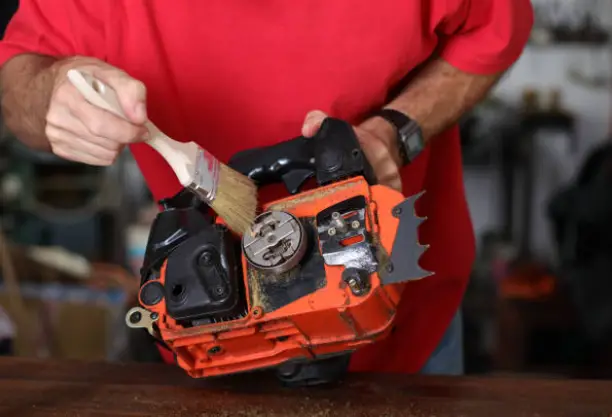
Step Five: The Oil Reservoir
On most chainsaws, the oil reservoir automatically squirts lubrication onto the chain as it moves.
However, the chain lubrication hole can become clogged with sawdust and debris after a while, meaning that the bar and chain aren’t getting the lubrication they need for smooth operation and efficient cutting.
These holes are different sizes depending on the brand and model, but if you can see that it is blocked, clean it out by gently pushing something thin into the hole to carefully scrape out the gunk. Don’t force it, or you may damage the oil reservoir.
Step Six: Clean The Rest Of The Chainsaw
It’s best to leave this until last as you’ll probably make it dirty again when removing the other parts.
Gently brush off any loose debris, then wipe the machine down with a damp cloth and warm soapy water and allow it to dry (or dry it with a clean cloth). For battery chainsaws, check the battery for damage and wipe it over with a cloth. Make sure that the electrodes are free from dust and dirt, and clean them with a wire brush if necessary.
Stubborn grime can accumulate if the machine has had heavy use without being cleaned regularly, so you may need to scrape it off with a putty knife or a tool with a wide blade. Take care not to scratch the casing!
Although some chainsaw users don’t mind their machines looking dirty, I prefer one that’s clean all over. It’s about taking pride in your tools and looking after them. Also, it gets you into the habit of regular maintenance and care.
If you start this when the chainsaw is new, you’ll keep it looking good and working well for many years.
Step Seven: Reassemble The Chainsaw Parts
You now have a clean electric chainsaw, and it’s time to put all the parts back together. It’s essential that you do this correctly, so refer to the chainsaw’s manual if necessary.
Make sure the chain and guide bar are fitted and tightened to the right tension and that the chain is facing in the correct direction.
Once you have assembled the chainsaw safely, you need to store it securely. Always use the chainsaw bar cover provided by the manufacturer, as this protects the teeth from being damaged and prevents accidents from happening. If your machine didn’t come with one of these, it’s a good idea to invest in one.
Keep your chainsaw in a dry place that’s ideally a constant ambient temperature. For models with a power cord, loop this loosely, cover it with a plastic bag and hang it where it won’t be damaged.
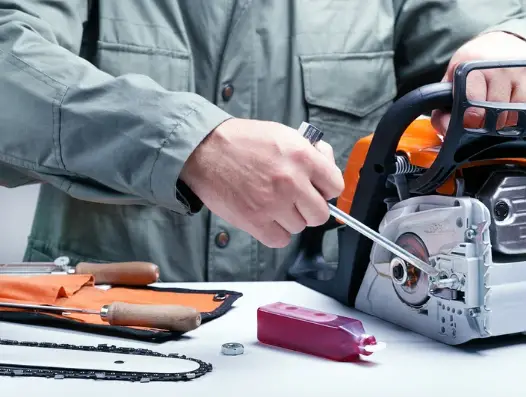
Step Eight: The Power Cord
If your electric chainsaw runs off mains electricity, you need to check the cord thoroughly for damage. These can become caked in dirt and debris, so it’s a good idea to wipe them with a damp cloth – making sure that it is disconnected from the power source!
This is the most important feature of your chainsaw; without a functioning power cord, your machine is neither use nor ornament. Wiping it down and keeping it clean gives you the opportunity to check for nicks or breaks in the casing.
Damaged cables and exposed wires present a serious health hazard, so it’s in your best interests to examine the power cord regularly.
This includes checking the connection to the chainsaw as well as the plug and any extension cords you use.
Most power tools these days – especially those for the garden – are double insulated, so the risk of electrocution is low, but not impossible. As a double precaution, you could invest in a circuit breaker that cuts the power in milliseconds if there is an electrical problem.
The Advantages Of An Electric Chainsaw
While you might think that the maintenance and cleaning process for an electric chainsaw is a chore, it’s nothing when compared to a petrol model!
With gas chainsaws, as they are known in the US, you have to check the air filter, spark plug, fuel tank, cooling fins, clutch drum and a host of extra parts. So, on the whole, an electric chainsaw is a lot less bother.
However, because you can use them for longer, cordless chainsaws tend to get dirtier much quicker. Also, you are limited by the power cord, unless you have a battery-powered chainsaw.
Even so, the electric chainsaw is generally considered a better choice, at least for domestic use. Most home gardeners don’t need a big, powerful petrol chainsaw. These are more suited to professionals who spend days out in the wilds and forests, cutting down larger trees.
An electric chainsaw is fine for occasional use when smaller trees need to be kept in check, or branches need pruning.
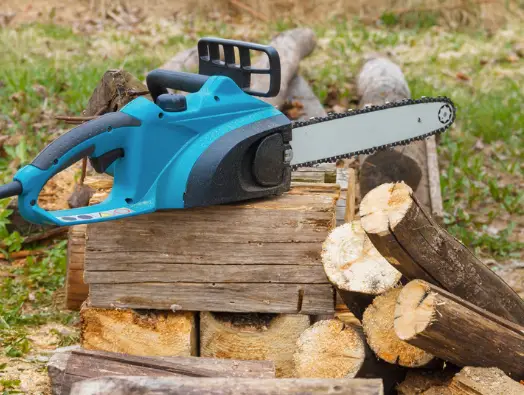
How Not To Do It
Online forums can be a handy source of information on a lot of subjects. They can also be an alarming experience when you read the hair-raising accounts and suggestions that many armchair experts offer.
For example, some chainsaw users recommend neat petrol to clean your chainsaw. Others claim that they take them to the carwash periodically, or use a pressure washer to hose them down.
Let’s be clear – none of these are wise options. In fact, they are incredibly stupid, especially for electric chainsaws!
In my honest opinion, it’s best to avoid these forums altogether. Admittedly, most of these chainsaw users are referring to petrol models. Maybe the fumes have affected their judgement over the years?
How To Clean An Electric Chainsaw: In Conclusion
When you break it down, it’s not exactly a difficult job, is it?
You’ll only need to set aside a couple of hours to do this, and it will extend the life of your chainsaw no end.
These machines can cost from between £60 right up to £300 or more, so, depending on your financial circumstances, you might not want to splash out for a new one right now – especially as prices for everything seem to be rising every week!
Cleaning and maintenance makes good sense, so why not take the time to do it?
So now you have the information and it’s up to you. All that remains to be said is to use your chainsaw safely, and happy sawing!


